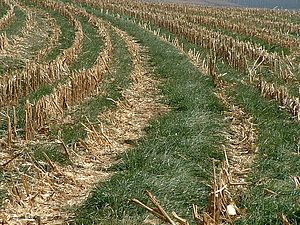Conservation Practices Become Widespread in Chesapeake Bay

A rye grass cover crop between corn stalks. Photo by wikimedia.org.
A new report from the USDA offers hope that conservation practices can spread widely in a region in a relatively short period of time. The report shows that adoption of farm conservation practices in the last five years have led to significant offsets of water pollution. The combined conservation practices have lowered the estimated average edge-of-field losses of eroded soil by about 15.1 million tons per year.
The report compared data collected between 2003 and 2006 with data collected in 2011. This is the first time USDA has compared changes in conservation practices in a specific region over two points in time.
One agricultural practice that has increased dramatically is the use of cover crops. Cover crops are planted on a field to hold the soil after the cash crop has been harvested. In the spring cover crops can be tilled in to provide a form of green manure. Since 2006, land with cover crops in a cropping system increased from 12 percent of acres to 52 percent. The increased use of agricultural practices came about because of a special Chesapeake Bay Watershed Initiative within the 2008 Farm Bill. However, since the 2008 Farm Bill expired there has been a reduction in technical and financial assistance available through the initiative.
The report did not address possible increases in pollution loading associated with development of more land or an increase in the number of acres of annual crops such as corn. In the past such land conversions have offset some of the gains brought about with increased conservation practices.
